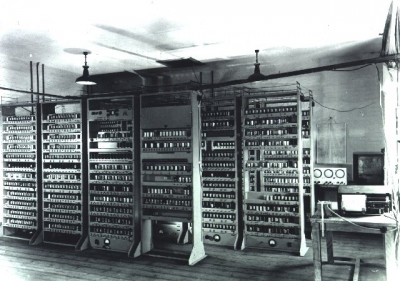The von Neumann architecture also known as the von Neumann model or Princeton architecture is a computer architecture based on a 1945 description by John von Neumann, and by others, in the First Draft of a Report on the EDVAC. The document describes a design architecture for an electronic digital computer with these components:
A processing unit with both an arithmetic logic unit and processor registers
A control unit that includes an instruction register and a program counter
Memory that stores data and instructions
External mass storage
Input and output mechanismsThe term "von Neumann architecture" has evolved to refer to any stored-program computer in which an instruction fetch and a data operation cannot occur at the same time (since they share a common bus). This is referred to as the von Neumann bottleneck, which often limits the performance of the corresponding system.The design of a von Neumann architecture machine is simpler than in a Harvard architecture machinewhich is also a stored-program system, yet has one dedicated set of address and data buses for reading and writing to memory, and another set of address and data buses to fetch instructions.
A stored-program digital computer keeps both program instructions and data in readwrite, random-access memory (RAM). Stored-program computers were an advancement over the program-controlled computers of the 1940s, such as the Colossus and the ENIAC. Those were programmed by setting switches and inserting patch cables to route data and control signals between various functional units. The vast majority of modern computers use the same memory for both data and program instructions, but have caches between the CPU and memory, and, for the caches closest to the CPU, have separate caches for instructions and data, so that most instruction and data fetches use separate buses (split cache architecture).
The Electronic Delay Storage Automatic Calculator (EDSAC) was an early British computer. Inspired by John von Neumann's seminal First Draft of a Report on the EDVAC, the machine was constructed by Maurice Wilkes and his team at the University of Cambridge Mathematical Laboratory in England. EDSAC was the second electronic digital stored-program computer to go into regular service.Later the project was supported by J. Lyons & Co. Ltd., intending to develop a commercially applied computer and succeeding in Lyons' development of LEO I, based on the EDSAC design. Work on EDSAC started during 1947, and it ran its first programs on 6 May 1949, when it calculated a table of square numbers and a list of prime numbers. EDSAC was finally shut down on 11 July 1958, having been superseded by EDSAC 2, which remained in use until 1965.

1949May, 6
EDSAC, the first practical electronic digital stored-program computer, runs its first operation.
Choose Another Date
Events on 1949
- 1Apr
Communist Party of China
Chinese Civil War: The Chinese Communist Party holds unsuccessful peace talks with the Nationalist Party in Beijing, after three years of fighting. - 20Jul
1948 Arab-Israeli War
Israel and Syria sign a truce to end their nineteen-month war. - 1Oct
Mao Zedong
The People's Republic of China is established and declared by Mao Zedong. - 2Oct
Mao Zedong
The Soviet Union recognises the People's Republic of China, proclaimed the previous day by Mao Zedong. - 14Oct
People's Liberation Army
Chinese Civil War: Chinese Communist forces occupy Guangzhou.

 English
English  español
español  français
français  português
português  русский
русский  العربية
العربية  简体中文
简体中文 